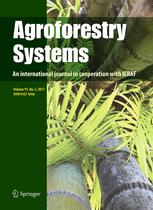Ver ítem
- xmlui.general.dspace_homeCentros Regionales y EEAsCentro Regional Patagonia NorteEEA BarilocheArtículos científicosxmlui.ArtifactBrowser.ItemViewer.trail
- Inicio
- Centros Regionales y EEAs
- Centro Regional Patagonia Norte
- EEA Bariloche
- Artículos científicos
- Ver ítem
Evaluation of plantation and early development of five alternatives to ponderosa pine in silvopastoral systems in northwest Patagonia, Argentina
Resumen
En la región patagónica de Argentina, silvopastoril, los sistemas se basan en las plantaciones de coníferas exóticas en pastizales naturales del ecotono estepa-bosque Pino ponderosa es la especie más ampliamente utilizados en forestación en la Patagonia. Con el fin de mejorar la rentabilidad económica de los sistemas silvopastoriles, alternativa
especies con mayor valor por unidad de volumen de la madera, la cual se puede sembrar en las zonas donde el
[ver mas...]
En la región patagónica de Argentina, silvopastoril, los sistemas se basan en las plantaciones de coníferas exóticas en pastizales naturales del ecotono estepa-bosque Pino ponderosa es la especie más ampliamente utilizados en forestación en la Patagonia. Con el fin de mejorar la rentabilidad económica de los sistemas silvopastoriles, alternativa
especies con mayor valor por unidad de volumen de la madera, la cual se puede sembrar en las zonas donde el pino ponderosa. Actualmente se cultiva, deberán ser identificadas y evaluadas. Este trabajo apunta a evaluar la viabilidad de la plantación de cinco especies de frondosas (nativas y exóticas) con mayor valor intrínseco de madera de P. ponderosa bajo dos condiciones de siembra: con y sin un árbol
[Cerrar]
Previous studies of afforestation in Patagonia indicate that 30–50 % tree cover produces positive effects on the pasture. This coverage level is achieved by applying pruning and strong thinning to reduce the volume of timber production per area unit. From an economic standpoint, in order to not reduce the income level of the system, it is necessary to find tree species that could replace ponderosa pine (Pinus ponderosa) and maximize income per volume unit
[ver mas...]
Previous studies of afforestation in Patagonia indicate that 30–50 % tree cover produces positive effects on the pasture. This coverage level is achieved by applying pruning and strong thinning to reduce the volume of timber production per area unit. From an economic standpoint, in order to not reduce the income level of the system, it is necessary to find tree species that could replace ponderosa pine (Pinus ponderosa) and maximize income per volume unit of wood. We evaluated the feasibility of implementation of five broadleaved tree species (native and exotic) with higher intrinsic wood quality than ponderosa pine. We tested the influence of tree cover generated by a framework of silvopastoral plantation on the increase in survival, regrowth and absolute increase in height, and compared ecophysiological variables (net photosynthetic activity, stomatal conductance, intrinsic water use efficiency) of different species to the status of a traditional plantation without tree cover. Additionally values of air temperature and relative humidity were registered under both cover conditions. Preliminary results support the conclusion that three of these five species could be considered as alternatives to ponderosa pine species for establishing silvopastoral systems with higher timber value. Our Based on the results, the use of tree cover generated under the current plantations of P. ponderosa could increase the success of the establishment of these species.
[Cerrar]

Autor
Varela, Santiago Agustin;
Caballe, Gonzalo;
Willems, Priscila Mabel;
Diez, Juan Pablo;
Godoy, María Marcela;
Fuente
Agroforestry systems 91 (5) : 981–991. (October 2017)
Fecha
2016
ISSN
0167-4366 (Print)
1572-9680 (Online)
1572-9680 (Online)
Formato
pdf
Tipo de documento
artículo
Palabras Claves
Derechos de acceso
Restringido
 Excepto donde se diga explicitamente, este item se publica bajo la siguiente descripción: Creative Commons Attribution-NonCommercial-ShareAlike 2.5 Unported (CC BY-NC-SA 2.5)
Excepto donde se diga explicitamente, este item se publica bajo la siguiente descripción: Creative Commons Attribution-NonCommercial-ShareAlike 2.5 Unported (CC BY-NC-SA 2.5)

